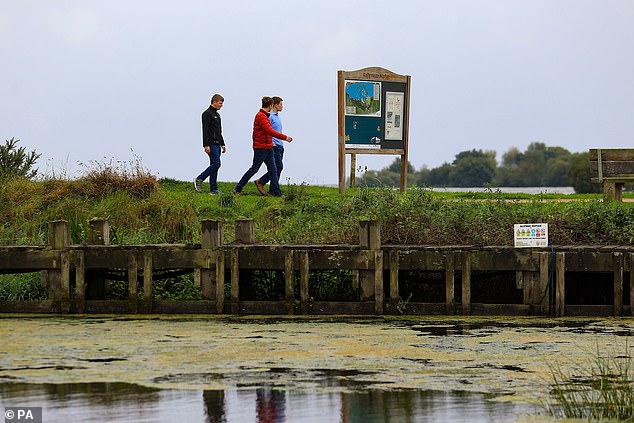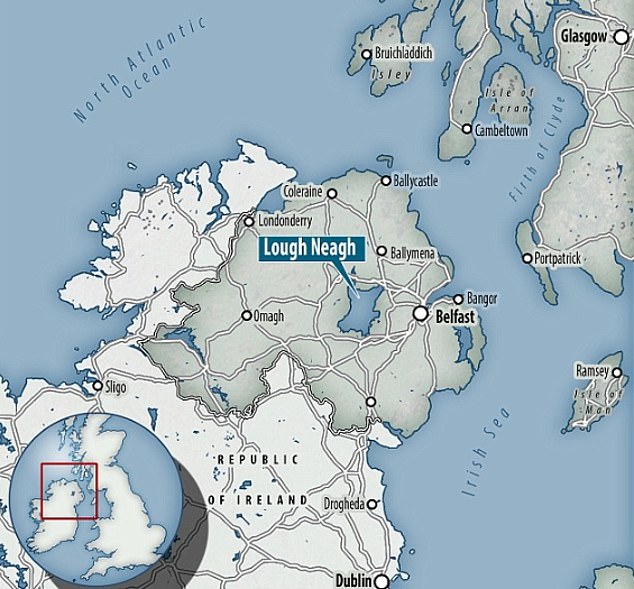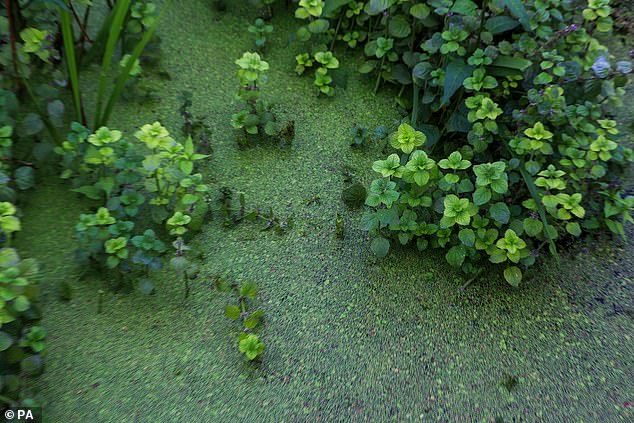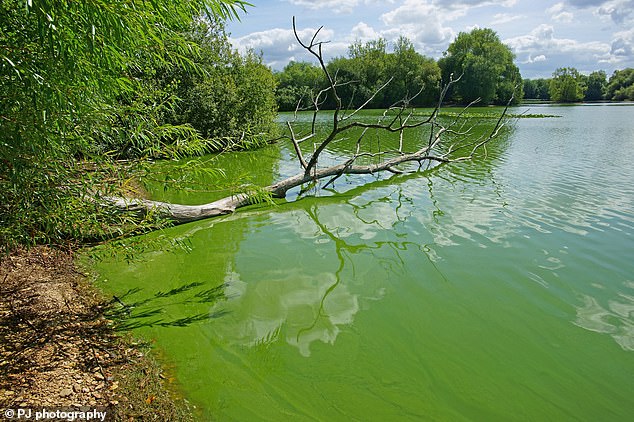Warning over toxic green ‘mashed potato’ foam that can kill dogs in just 24 HOURS: Pet owners warned about poisonous algae seeping into rivers, lochs and ponds that’s lethal to animals
>
Experts have warned dog walkers to be wary of a toxic algae that resembles ‘green mashed potatoes’ and could be fatal if ingested.
Blue-green algae spreads in ‘blooms’ across lakes and rivers, turning the water a vibrant green color and giving it an earthy or musty odor.
But the substance contains toxins that cause a dog’s liver to malfunction, potentially leading to death within an hour.
A woman tragically lost her beloved two-year-old dog less than 45 minutes after he came into contact with the deadly substance at a lake in Somerset.
Another hard-hit freshwater lake – Lough Neagh in Northern Ireland – is currently being devastated by the algae, which have formed uncontrollable blooms over the summer.
Experts have warned dog walkers to be wary of a toxic algae that resembles ‘green mashed potatoes’ and could be fatal if ingested

Blue-green algae spread in ‘blooms’ across lakes and rivers, turning the water a vibrant green color and giving it an earthy or musty odor

Harmful algae blooms covered large parts of Lough Neagh in Northern Ireland last summer
It comes as environmental campaigners in Lough Neagh organize a ‘vigil’ to mark the death of the famous lake due to the substance, officially known as cyanobacteria.
Lough Neagh, the largest freshwater lake in Britain and Ireland, supplies 40 percent of Northern Ireland’s drinking water and supports an important eel fishery.
Although ingestion of the cyanobacteria is not known to be fatal to humans, it can cause us serious diseases.
“The state of the lake at the moment is absolutely appalling,” environmental scientist Dr Leslie Gornall told BBC Radio 4 on Thursday.
“At the end of the lake is a green, mashed potato-like crust that is at least six inches deep and possibly twenty-five inches deep.
“If you stick a boat’s oar in, the entire blade of the oar can scoop up and act like a shovel… it smells disgusting.”
Blue-green algae contain toxins that can kill livestock, wildlife and pets – both cats and dogs.
‘If you drop your dog in there to chase a ball, he’ll come out, lick his fur and then he’ll be dead within 24 hours,’ said Dr Gornall.
‘Immediate action is needed or not only will we lose the lake, but the Lough Neagh eel will become extinct… and so will tourism.’

Lough Neagh supplies 40 percent of Northern Ireland’s drinking water and supports a large eel fishery, but is being devastated by the algae

Algae on the surface of Lough Neagh as environmentalists hold a vigil to protest the lack of action

An adorable two-year-old Flat-Coated Retriever named Cove (pictured) died less than 45 minutes after being poisoned by blue-green algae in Somerset
Blue-green algae is in no way unique to Lough Neagh and blooms have recently been observed in Lake Windermere in Cumbria, Highams Park Lake in London, Jubilee River in Berkshire and Wimbleball Lake in Somerset.
An interactive map shows locations of the cyanobacteria in UK waters, as reported by members of the public.
The bloom makes the water resemble pea soup or spilled green paint, but it can also resemble firmer clumps or foam, especially near the shoreline.
Some municipalities have posted signs warning of the dangers of a lake being poisoned by the flowers, but this is not always the case.
Dogs that run away from their owners while off-leash can enter an affected river or lake before the owner even realizes it.
A spokesperson for the Blue Cross said there is no antidote for the toxins produced by the blue-green algae.
“If you catch it early enough, your vet will likely try to make your dog sick and try to flush the toxins out of the body before they take hold,” they said.
‘Unfortunately, blue-green algae poisoning often ultimately causes fatal liver failure.’
In humans, contact with blue-green algae can cause a rash, nausea, stomach pain, fever and headache.
According to the Blue Cross, there have been some reports of more serious illnesses, including liver and brain damage, but there have been no confirmed human deaths.
Children are at greater risk than adults of developing problems due to their relatively lower body weight.

Affected waters at Frampton on Severn in Gloucestershire. Algae growth is related to excess nutrients in the water

Sign at Preston Marina in Lancashire warns the public of the dangers of blue-green algae
Due to the health risks, anglers are urged not to eat anything they catch from water they suspect is affected.
Although the cyanobacteria are not a new species, their growth has been fueled by the summer heat in recent months.
A combination of warm temperatures, sunlight and nutrient-rich water causes blue-green algae to reproduce or ‘bloom’ quickly.
Nitrogen and phosphorus from agricultural fertilizers flowing from fields are believed to be another major factor – so many blame farmers.
The spread of the invasive species of zebra mussel is also thought to have played a role, as they have made the water clearer, allowing more sunlight to penetrate and boosting photosynthesis.
